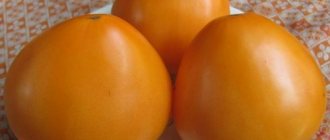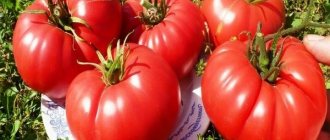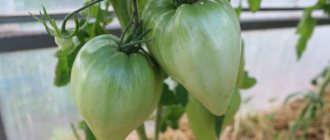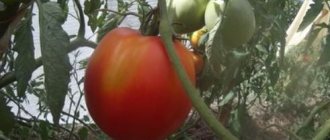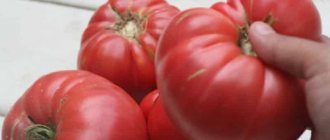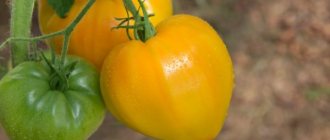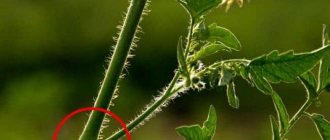The tomato harvest depends more than 50% on the quality of the seeds. The pink oxheart tomato is a popular giant, known not only for its impeccable taste and benefits. The non-hybrid variety reproduces well from its own seeds, is easy to care for, and produces a lot of fruit.
| Height | Landing location | Ripening time | Fruit color | Fruit size | Origin | Fruit shape |
| Tall | Greenhouse, Open ground | Mid-season | Pink | Large | Variety | Heart-shaped |
Description of the tomato variety Bull's heart pink
The variety belongs to the giants of the determinant type, i.e. it is limited in growth. The maximum height of the plant is 200 cm. The Pink Oxheart tomato is mid-season, the period between the emergence of shoots and the ripening of the fruit is 125-135 days.
The tomato bush is erect, highly branched, and does not look powerful in appearance. The stems are thin and require constant garter. The leaves are large, bright green, dissected. The inflorescences are complex, the stalk is without articulation. The root system is well developed, distributed both over the surface and deep into the soil.
The fruits of Pink Ox's Heart are considered one of the best in terms of consumer qualities.
Description of fruits
Tomato fruits at the ripe stage have a soft crimson color. Their shape is heart-shaped, irregular - wide at the top and narrowed at the bottom. The tomatoes are very large, especially on the lower clusters, they can reach a weight of 600 g, while on the upper clusters the fruits are much smaller (200-300 g). Pink Ox's Heart tomatoes are juicy, sweetish, with sourness and a characteristic tomato aroma. The pulp is sugary and fleshy. The amount of dry matter (brix) is 5%. There are few seeds, they are located in 2-4 small chambers. The skin is of medium density and may crack after ripening due to changes in temperature and humidity.
Variety varieties
Due to its great popularity, the tomato has many varieties that have similar characteristics but differ in color.
Pink
These include the following subspecies of the variety:
- Pink. A mid-late giant, the weight of the fruit reaches 600 g. Planting is carried out both in open ground and in a greenhouse. The main feature is the location on one bush of both large and very small fruits (up to 100 g). Does not apply to shelf-stable varieties: the shelf life of ripe tomatoes does not exceed 10 days;
- Abakanskoe. In a temperate continental climate, it is advisable to grow in a greenhouse. Needs a garter to a very strong support. It is better to form into one stem;
- Michael's Pink. A very rare early subspecies. The fruit looks like a giant heart;
- Babushkino. An indeterminate hybrid, the height of the bush can reach up to 160 cm. The weight of tomatoes reaches 0.5 kg;
- Joe pink. The weight of the fruit can exceed 1 kg. Carpal plant. High yield;
- Chernigovskoe. A sweet, fleshy tomato with an average ripening period, grown in open ground and in greenhouses;
- Favorite holiday. Bred by breeders from Siberia. Ideal for planting in areas of central Russia. Determinate plant. The weight of the fruit can reach 1.3 kg;
- Fish Lake. The family subspecies is native to Canada. Has a high sugar content. Average weight – 350-600 g. In a temperate continental climate, it is advisable to grow tomatoes in greenhouses;
- Compact A low-growing subspecies that does not require powerful support. Tomatoes are characterized by early ripening - already 100 days after the sprouts appear, fruits are formed.
The shades of this type of tomato vary from bright pink to pink-raspberry.
Reds
Subspecies that have red fruits of varying intensities include:
- Minusinsk Exhibition. Bright red tomato, reaching a weight of 0.6 kg. Virtually no seeds;
- Striped. The carmine-red skin has dark stripes. Bushes grow up to 170 cm. When growing, they need a garter;
- German Homer. A very popular mid-season hybrid tomato. In 2014, it was recognized as the largest-fruited: fruit weight reaches 1.5 kg. The peculiarity of the tomato is the presence of small ribs;
- French. The plant is easy to care for, resistant to diseases and lack of moisture;
- Linney. Medium-sized, mid-early subspecies. A tomato turns red when ripe. Contains a small amount of seeds. The weight of the fetus reaches 680 g.
Yellow
There are also yellow subspecies of this variety:
- Dawson's Russian. Amateur subspecies. Fruit weight is from 0.8 to 1 kg. They are yellow with red veins;
- Golden. The hybrid was obtained by artificial pollination of 2 varieties, which is marked f1. Late ripening plant. The fruits are dense and smooth, weight - from 240 to 280 g;
- Orange. New. A tomato with the shortest growing season (115 days pass from the moment sprouts appear to full ripening) and unlimited growth of the bush (its height reaches 180 cm). The color of a ripe vegetable is yellow-orange, weight – from 150 to 400 g.
The yellow varieties have an unusual and beautiful appearance, and the fruits have a wonderful taste.
Tatyana Orlova (Vasilidchenko) (candidate of agricultural sciences):
All the varieties described above have fruits that are similar in shape, but have nothing to do with the Bull’s Heart variety. The classic variety Bull's Heart has a raspberry-pink color and is a semi-determinate variety. Its height is 100-120 cm. This variety was and is grown with the obligatory garter on stakes.
White
The bush of the White Bull's Heart variety can grow up to 1.5-2 m in height. When ripe, the tomato becomes white-yellow (less often pinkish). The pulp is yellow.
Most often, a tomato weighs from 200 to 300 g, some “giants” grow up to 600-800 g. Recommended for baby food due to its hypoallergenicity. The crop needs staking due to its high growth.
Black
The Oxheart black tomato has a brown-burgundy peel color with a black tint. The tall crop (reaching more than 1.5 m) produces heart-shaped fruits weighing from 350 to 600 g. It is distinguished by a dense, non-cracking peel, which guarantees good transportability and preservation of its presentation for a long time.
One bunch will grow up to 7 tomatoes. The harvest is harvested quite late - in August and September.
Raspberry
The fruits reach a weight of more than 500 grams
The Raspberry subspecies is distinguished by its increased resistance to various climatic conditions: it is able to grow in the north of Russia, in the central regions of the country (Moscow region), and in the southern regions. The tomatoes are smooth, heart-shaped, raspberry in color, weighing 350-600 g.
The bush is spreading, consists of several stems. Up to 4 tomatoes are tied on one brush.
Characteristics of tomato Ox heart pink
The variety is intended for cultivation both in greenhouses and without shelter, in open ground. It is necessary to constantly shoot plants in order to form them correctly into 2-3 stems and not to thicken the plantings. The Pink Bull's Heart tomato is recommended for cultivation in the central regions and southern regions of the Russian Federation.
The keeping quality of the variety is low, the maximum shelf life is no more than 2 weeks. Seed germination is 85-90%.
In the middle zone, seedlings are planted in a greenhouse at the beginning of May, in open ground at the end of the month
Tomato productivity Bull's heart pink and fruiting
Tomato produces maximum yield in regions with a mild climate. But even in the conditions of Siberia, the first brushes have time to ripen. On average, you can get 15 kg from one bush when grown in a greenhouse and 5 kg in open ground. It takes at least 4 months to reach maturity. The yield of the Pink Bull's Heart variety largely depends on the quality of the seeds, seedlings, soil composition, timeliness of watering and pinching.
Important! Gradual removal of leaves stimulates the ripening of fruits.
Harvest begins in July and continues until September as the tomatoes ripen and depending on the growing region.
Area of application of fruits
The Pink Ox's Heart tomato has a wonderful rich taste, so it is widely used for fresh consumption, in salads and sandwiches. It is indispensable for preparing juice, puree, paste, sauces both at home and on an industrial scale. The variety is not suitable for preservation due to the large size of the fruits. They can be dried and further used for cooking. Small tomatoes can be pickled or pickled.
Resistance to diseases and pests
The Pink Bull's Heart variety is characterized by average resistance to major diseases. As a result of violations of agricultural cultivation techniques and unfavorable weather conditions, tomatoes can be affected by diseases. Late blight often develops against the backdrop of cold weather and irregular ventilation of greenhouses. A deficiency of calcium in the soil leads to blossom end rot. Cladosporiosis develops in high humidity and in the presence of infected plants. By creating the proper conditions and carrying out preventive measures, the development of diseases and the spread of pests can be stopped.
Planting and care
Seeds are sown in mid-late March. The soil is fertile and light. Seed to a depth of 1.5-2 cm, width between grooves 2 cm. Sprinkle with nutrient mixture or mulch. Cover with film and wait for shoots to appear, then remove the covering. Moisten with a spray bottle and water through a strainer with warm, settled water. Harden for a week at a temperature of 15 ° C. Then they are grown at 18-20 °C. They dive when there are 2-3 true leaves.
They are transplanted into the greenhouse after 50-60 days from the moment of germination. In open beds - at the end of May.
For successful ripening and large size of tomatoes, leave no more than 6-7 fruit clusters.
Advantages and disadvantages
Despite its external elegance, thin shoots and limited growth, the variety amazes with its ability to produce giant fruits. If you tie up the plants in time, the tomatoes stay perfectly on the branches and reach technical ripeness right on the bushes. And this is not the only advantage of the Pink Bull's Heart tomatoes.
To preserve the fruits, they are laid out in cardboard boxes in a single layer and placed in a cool, dark place.
pros
- ease of care;
- possibility of collecting seed material;
- resistance to a number of diseases;
- excellent taste and appearance of the fruit;
- high productivity;
- easy tolerance to dry periods;
- simultaneous appearance of several ovaries in the hand;
- excellent seed germination rates.
Minuses
- uneven fruit size;
- short shelf life of tomatoes;
- low transportability;
- the need for pinching and tying;
- prone to cracking.
Bush care
How to care:
- In the first days after planting, the seedlings are not watered. Water for the first time after 10-12 days;
- Watering is carried out directly under the root, two to three times a week in the evening before sunset. During intensive ripening of tomatoes, water once a week;
HELP: Due to excess moisture, the fruits become watery and begin to crack.
- For irrigation, use settled warm water;
- Usually the main shoot and the first stepson are left, the remaining stepsons and lower leaves are removed. In order for the tomatoes to fully ripen and grow normally, leave 6-7 bunches.
Features of cultivation
Pink Oxheart tomatoes are grown using seedlings, with their further planting in a greenhouse or open ground. To obtain a good harvest, it is necessary to carry out all the necessary agrotechnical measures.
Ideal conditions for the growth of tomatoes Ox heart pink - soil humidity 85%, air humidity - 50%
Growing seedlings
Sowing is carried out two months before the intended planting of seedlings. Seeds are sorted, discarding low-quality seeds by immersion in a saline solution (1 teaspoon per glass of water). Only those that have settled to the bottom are selected. Next, they are pickled in a solution of potassium permanganate, soaked in a growth stimulator, hardened in the refrigerator and bubbling, saturating with oxygen.
For sowing, prepare a soil mixture of peat, sawdust and greenhouse soil mixed in a ratio of 1:1:2, disinfect it with a solution of potassium permanganate, calcination or freezing. The moist soil is placed in disinfected containers, the seeds are laid out on the surface, and covered with a small layer of soil mixture. Covering the top with film, the boxes are transferred to a warm place. As soon as the sprouts appear, the containers are placed in a cooler room, where additional lighting is installed for the Oxheart pink tomato seedlings. Picking is carried out in the phase of three true leaves, repeating the operation after another three weeks. To increase the immunity of seedlings, it is recommended to spray them with a growth stimulator solution at the age of 10 days. Watering must be done carefully, at the root, as the soil dries.
Seedlings are planted in the phase of 5-7 true leaves.
Landing
Holes are prepared for plants, distributing them at a distance of 60 cm and 50 cm between rows. After planting the tomatoes, they are watered with warm, settled water, and the soil is mulched. If there is a possibility of return frosts, seedlings need to create temporary shelter.
Watering and fertilizing
You can get a good harvest only with timely care. The recommended watering regime is twice a week with a consumption of 2 liters of water for a young plant and 5 liters for an adult. Moistening should be done early in the morning so that drops do not fall on the foliage and cause burns.
Fertilizing the tomato Ox's heart pink is carried out three to four times per season:
- nitrogen fertilizers - at the beginning of the growing season;
- phosphorus-potassium - during fruit set;
- with boron and magnesium in the composition - at the time of budding and formation of ovaries;
- potassium - when the tomatoes ripen.
Pinching, tying and shaping
Throughout the growing season, it is necessary to carefully monitor the timely destruction of stepsons so that the plant does not thicken. It is formed into 2-3 stems, removing all excess. As it grows, it needs to be tied to a support or trellis, which must be strong and reliable.
Planting time for seedlings
For seedlings, it is recommended to plant seeds in March (at the end). It should be placed in the ground to a depth of 15-25 mm, diving is done when 1-2 leaves appear. Before planting in open ground, grown seedlings need feeding. For these purposes, a complex of special fertilizers prepared for seedlings is used. Before planting, the shoots are hardened off for 8-12 days.
When planting tomatoes in a heated greenhouse, the bushes are transplanted in April, and into open ground in May (end).
Pest and disease control
Despite the average resistance to late blight infection, the Pink Bull's Heart tomato is not immune to fungal diseases and attacks by insect pests.
Most often it is affected by:
- Gray rot - the formation of brown spots and further fluffy coating on all parts of the plant.
- Cladosporiosis - gradually growing yellow spots, leading to leaf fall.
- Aphids are insects that settle on plants and suck their juice.
- Tomato cutworm - its caterpillars eat the green mass of tomatoes.
Insecticides (Decis, Karate, Akarin) will help in the fight against pests; fungicides (Skor, Fundazol, Ordan) are used to treat fungal pathologies.
